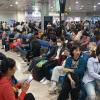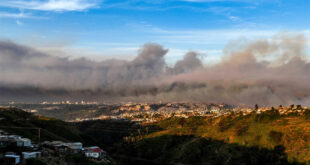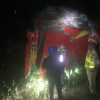Post-Covid, Hanoi has bid goodbye to quiet streets, and the old congestion is back with a vengeance.
At 6 p.m. one August day at the Nguyen Trai-Khuat Duy Tien intersection, thousands of vehicles were moving an inch at a time, with the noise of engines, the smell of exhaust smoke and the sweltering heat making for a nightmare scenario.
But it is a common scene for most Hanoians.
 |
|
Traffic on Nguyen Trai Street in Hanoi, August 8, 2022. Photo by VnExpress/Ngoc Thanh |
The problem of gridlock in the capital city is exacerbated during holidays, as seen on September 4, the last day of the four-day holidays for Independence Day, when vehicles had backed up for two kilometers on the Phap Van – Cau Gie expressway.
The April 30 – May 1 holidays had witnessed similar scenes.
“We left the station at 7 a.m. and reached here at 9 a.m., or two hours for a 10-km drive,” Nguyen Son, a VTV reporter, recounted his trip on Nguyen Xien Street, Thanh Xuan District. on April 30.
“Many drivers climbed on pavements because the road was totally blocked.”
Congestion is again making headlines after two years of peace on roads due to the Covid-19 pandemic when people were told to stay at home.
Experts blamed poor urban planning for fragmenting the traffic system.
Burgeoning populace, limited traffic space
Traffic planning and engineering have been areas of focus for Hanoi authorities for many years, but they are failing to accommodate the growing population.
The 2019 census showed that the city’s population had grown at 2.22% a year during the previous decade since 2009, 1.5 times the nationwide average of 1.44%.
People flooding into the capital for job opportunities bring with them an overwhelming number of vehicles.
According to the traffic police office, more than 7.6 million vehicles are plying on the city’s roads, 5.8 million of them motorbikes.
The population growth is outpacing additions to traffic infrastructure with the lack of land being the biggest problem.
Normal urban planning standards require megacities to earmark at least 20-25% of their total land for traffic works, but in Hanoi it is only 10%. Meanwhile, the number of cars is growing at 12.9% a year.
The traffic capacity is not adequate for the population size and infrastructure is fragmented, Duong Duc Tuan, vice chairman of the city people’s committee, admitted.
High density of skyscrapers
Le Van Luong Street in the southwest of the capital has a high building density. The new road is home to some 40 skyscrapers along its two-kilometer length. So a large number of residents and white-collar workers have to weave around in heavy traffic every day. “Streets of misery,” regular commuters dub roads like this.
“Le Van Luong Street is an example of inadequate planning,” Nguyen Duy Hung, deputy head of the Central Economic Commission, said.
 |
|
Towering buildings on Le Van Luong Street in Hanoi, July 20, 2022. Photo by VnExpress/Ngoc Thanh |
Minh Khai (in Hai Ba Trung District) and Nguyen Tuan (Thanh Xuan District) are threatening to become competitors to Le Van Luong in the congestion stakes.
The increasing demand for housing and the shortage of land have caused property companies to deviate from licensed building designs.
In a report in June Ministry of Construction inspectors pointed out violations of construction laws such as exceeding permitted height and reducing communal spaces without approval.
Tran Ngoc Chinh, an architect and chairman of the Vietnam Association of Urban Planning and Development, said: “Skyscrapers built all over Le Van Luong Street only benefit developers, not the public.”
Vacant communal buses
There has been a dramatic rise in the number cars and motorbikes in the city since the end of the Covid pandemic, with over 145,000 new vehicles added in the first half of 2022, according to the traffic police.
But public transport remains incapable of attracting people.
Buses are the most economical and high-volume public means of transport, which if well patronized could reduce the number of private vehicles on the roads. However, bus services face a number of problems, illustrated by the recent termination of five routes.
Bac Ha, an old bus company, asked to stop operating on five regular routes, citing a high risk of bankruptcy due to lack of patronage.
Transerco, another bus operator, reported a 40% drop in ticket sales in the first half of this year.
Bad service, unreliable schedule and terrible infrastructure were blamed by people for not using buses.
A man identified only as Thai was quoted as saying by Giao Thong newspaper, “I never think of buses as my daily means of commute,” despite being an enthusiastic supporter of public transport.
“The distance between my workplace and home is around seven kilometers. It takes me 30 minutes on my motorbike. If I go by bus, it will take me one hour.”
The average speed of buses is 14-15 kilometers an hour though some go even slower: Route 32 between Giap Bat and Nhon and Route 03 between Giap Bat and Gia Lam, for instance, travel at 12 km/h.
Long distances and lack of walking spaces on pavements mean buses do not get many passengers.
With the rising fuel prices and rejection by customers, there is concern over the future of public transport in Hanoi among experts.
Nguyen Van Thanh, a former chairman of the Vietnam Automobile Transportation Association, told Lao Dong newspaper: “It is a vicious circle. The public is turning its back on buses. People are giving up the habit after the long period of social distancing. Many bus companies tell me about their losses.”
The overburdened roads are a major obstacle to Hanoi’s strategic development plans, and local authorities are scrambling for solutions.
But it requires long-term and systematic measures, executed sincerely, to bring about a solution.
- Reduce Hair Loss with PURA D’OR Gold Label Shampoo
- Castor Oil Has Made a “Huge” Difference With Hair and Brow Growth
- Excessive hair loss in men: Signs of illness that cannot be subjective
- Dịch Vụ SEO Website ở Los Angeles, CA: đưa trang web doanh nghiệp bạn lên top Google
- Nails Salon Sierra Madre
 VnExpress News The News Gateway of Vietnam
VnExpress News The News Gateway of Vietnam




